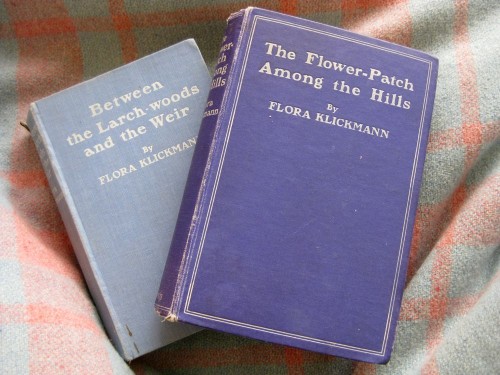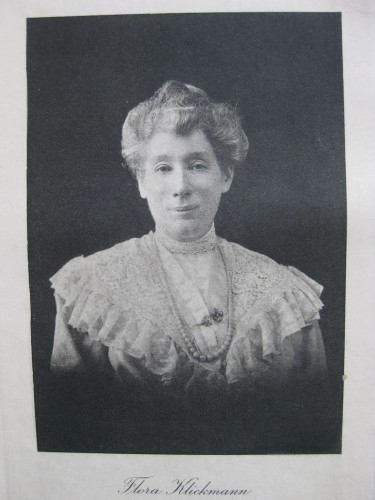I have a confession. Sometime I buy old books in op shops just because the books are pretty.
I know.
This is usually a really stupid habit, because our house is quite small, and I generally have to give the books back to op shops when I realise they are less fun to read than to look at.
Sometimes though, my “Oooh…bookey pogey bait” habit pays off, because I end up buying books that I have never heard of which turn out to be fantastic.
One of these fantastic and unexpected finds was two books by Flora Klickmann: The Flower-Patch Among the Hills and Between the Larch-woods and the Weir.
I really almost didn’t buy the books. They were $5 each, and I’d never heard of Klickmann. And they weren’t actually that pretty.
But I did, and they are fabulous.
Klickmann was the editor of the Girls Own Paper in London, and the first book (The Flower-Patch) started out as articles for the magazine. This means that both books are more a series of anecdotes than an actual story.
Klickmann’s rambles engagingly about her work as the editor of the magazine, the foibles of society, and (most frequently), her country house and garden in the Wye valley.
Her books are a bit heavy on floral descriptions (which she also tends to repeat), but give fantastic insight into the life of an upper-middle class working woman in England just before and during WWI.
Her descriptions of people she meets are both apt, and also very familiar. Haven’t we all known a Miss Quirker?
…a lady well over forty (or more), who apparently hasn’t anything at all to do, and who does it thoroughly well. She has a couple of very decided and conspicuous gifts – one is the ability to waste the time and dissipate the amiable qualities of every individual whose path she crosses; and the other is a positive genius for saying the wrong thing.
Less universal, but no less interesting, are her descriptions of life during the war: of rationing, and midnight gatherings among the neighbors when explosions are heard and it is feared that bombs are being dropped, of knitting, and ‘adopting’ sailors in the North Sea and supplying them with packages of baked goods.
Interlinked with the war stories are fashion anecdotes, as the rations affected fabric. Miss Quirker supplies a novel suggestion on economizing on corsets:
You should buy your corsets several sizes larger than usual, and then when they are getting worn, you can turn them upside down and wear them the other way up. It’s so saving.
Indeed. And so completely defeats the purpose of corsets and demonstrates such a complete lack of understanding of anatomy that it could only have been suggested by a military man.
We also get a description of the outfit of a well… tart of 1916.
Eileen was wearing a white Jap silk skirt; a transparent rose pink blouse, that revealed the satin ribbon and lace camisole beneath; pink cotton open-work stockings; white shoes; one of those long stoles made of metallic-looking lustre-brown fur, so beloved of the laundry girl; a bit white hat, trimmed with the most violent of tangerine-coloured velvet, said velvet hanging in festoons down the back, and loops of it caught round the front and fastened to the fur stole on one side with a large would-be-diamond lizard, about four inches long, and on the other with a crescent of similar make. Her hair, which was done in a wild imitation of the latest eccentricity of fashion, was radiant with more crescents and a sparkling three-tiered back comb. A string of large pearls adorned her neck.
Despite the popularity of the books in the teens and 20s (21 editions between 1916 and 1922) Klickmann’s writings have fallen out of favour in the decades since then. Perhaps it is the extensive and well, flowerly, chapters on flowers. Or the musings on religion and faith.
Whatever the case, I’m glad I found Flora’s books, and I wish they were available to more people. And don’t worry, I’ll be sharing lots of tidbits from them with you!





Ooooh, please share more tidbits! I love this type of book. I think they fall out of favor because they aren’t timeless, they’re too much in tune with their times. Surely you’ve had the experience of picking up a book from the 20’s and only understanding every fourth or fifth word because it’s so slangy and talks about all sorts of arcane social practices….? Or is that just me?
Sometimes I buy books in op shops because the idea of them makes me laugh. I don’t even limit myself to pretty ones. Like the well-thumbed bodice ripper from the 30’s about a white woman and a *gasp* Chinese man. It’s called Pearl of the Orient (Pearl being the heroine) or some such rubbish.. I crack a smile every time I see it on the bookshelf, so it’s worth the 50 cents I spent on it.
I figure I can always shred them to make lovely hand-made paper for journals if they are truly dreadful.
Wow…your book sounds hilarious! I’m scared by the idea of shredding them though :-S I have the whole ‘respect for books’ thing pretty firmly ingrained. Also, I have no time to make paper!
But if the book is truly, truly dreadful and of no use to anyone anywhere, then give it another life.
I don’t have time to make paper, either.. My husband fiddles around with it sometimes, makes cool cheap gifts.
The slang is the best part!
Agreed!
You sold me. I just went onto Amazon.com and bought copies of both those books…for twice what you paid. I think my mother would adore them as a gift (and I’ll borrow them!). 😀
Wow – that’s prompt! I do hope you and your mother enjoy them!
I wonder if there is much traction in the theory that one’s name affects one’s life. Flora- flowers. I did also try and draw some wise connection between Klickmann and writing based on byros but of course she is “pre byro” so that would be pushing it a little! 🙂 Lovely, I want to read them some time if I may? (when I have read the six other interesting old books in the pile by my bed!)
As soon as I read the books I thought “my, what a perfectly apt name she has!”. I didn’t try do do anything with the Klickmann bit, though she may have worked on a typewriter! And yes, you are most welcome to borrow them!
If you liked that, you should hunt down a copy of Agatha Christie’s autobiography. It’s hard to find, and don’t accidentally get her official biography, you want her autobiography. But I know Wellington libraries have it, that’s where I found it!
Oooh, so fun! Now people start suggesting books for me to read!
Four words for you, if you haven’t already encountered it.
“The Cult of Chiffon.”
I managed to nab a copy of Mrs Eric Pritchard’s oft-quoted volume on Ebay and honestly cannot work out why it hasn’t yet seen a facsimile reprint. It’s genius.
I have not, and now I’m off too!
In addition to a lot of really solid, good advice, it is LOADED with brilliant quotes like:
“As for the woman whose boots you can see a mile off, we do not wish to see her at all.”
and the illustrations are FABULOUS. I’m sure it must be in the public domain by now, so why it’s not been facsimiled yet beats me.
I have a copy of Cult of Chiffon after looking 10 years, and it cost me $350. I, too, think it’s amazing that this hasn’t been reprinted, especially as it’s quoted in so many fashion books. Though it would ruin the book, I’ve really wanted to scan it, put it in PDF form on a CD, and sell it for perhaps $5 each. The trouble is, I’m not certain how people manage to make such professional PDFs/CDs – what kind of scanner, what resolution, etc. – all the details. I must say, I wouldn’t mind ruining the book if it could be gotten out to more people. I’d rather quite a few people have access to it than to keep it o myself; I remember how frustrating it was waiting all those years – I’d like to save someone else that time and expense.
Thank you,
Ronda
rburroughs@wiley.com
I am just giving my daughter in law 8 bound volumes of The Girls Own Annual which I first bought about 30 years ago. I too was delghted with the wonderful paintings by Flora Klickman and have printed your pages to pass on to my daughter in law and granddaughter. Have to confess I have never opened the books until now!
I found small paperback books dated from 1925 by flora klickmann in my garage are they rare or just junk
Gordon, they are probably rare, but still not worth more than a pound or two. Take them to a used bookstore that specialises in old books, and see what they say.
antiquepatternlibrary.orgBooks by Klickman that you mentioned (as well as some others) can be read online or downloaded to a Kindle from http://archive.org. Some needlework books she edited are online at http://www.antiquepatternlibrary.org I happen to own a copy of one of her crochet books, and am very happy that such hard to find material is available for free, to inspire future needle artists.
People interested in fiction touching on sewing and needlecrafts in times past might try some of the 100 or so titles by Grace Livingston Hill, who started writing in the late 1800’s (in “According to Pattern”, a woman uses her needle skills to transform her wardrobe and home to lure back a straying husband.) In one of my favorites, 1925 “Not Under the Law”, a young woman who flees home with little more than the clothes on her back, creates cozy home in new town–even making a spring mattress by herself!–reflecting author’s own belief that she could make something that she’s set her mind to having. “Re-Creations” is about young woman who tho unable to finish her college training to become an interior designer, puts her talent to work transforming house in poor part of town. “White Lady” is partly inspired by Wilkie Collins “Woman in White”; again an attractive home is made by determined young woman with good taste . “A Daily Rate” describes how late 1800’s boarding house becomes inviting home .
Author Maud Hart Lovelace is beloved for her “Betsy” novels based on her life in early 1900’s–lots of descriptions of fashions of the times (“Emily of Deep Valley” is also neglected favorite of mine .